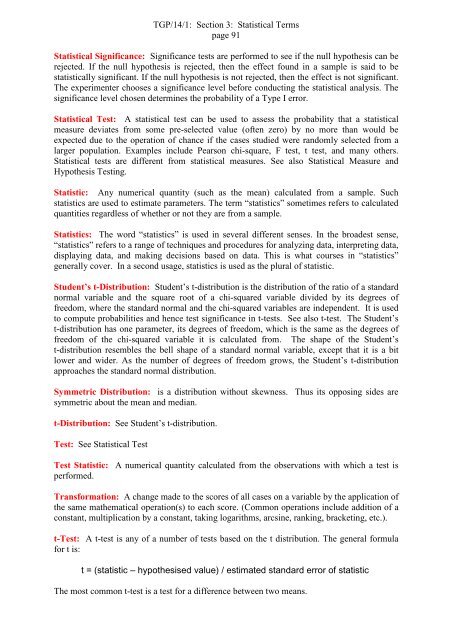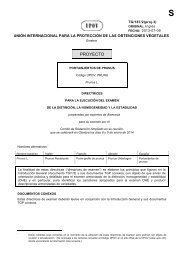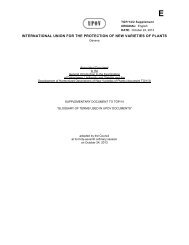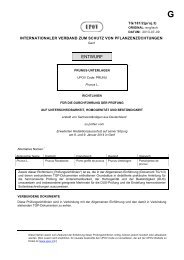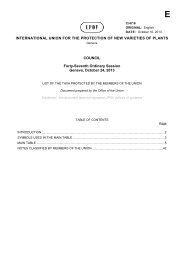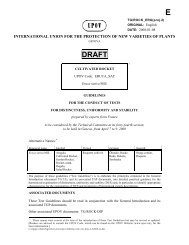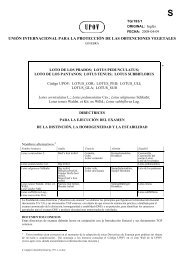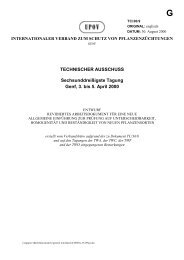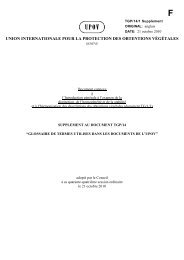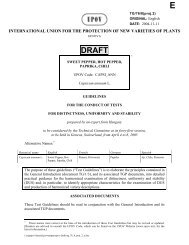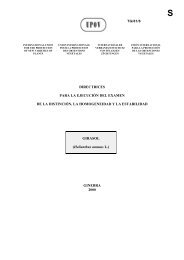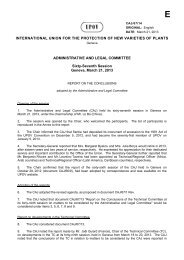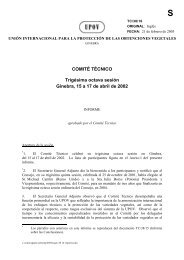E - International Union for the Protection of New Varieties of Plants
E - International Union for the Protection of New Varieties of Plants
E - International Union for the Protection of New Varieties of Plants
Create successful ePaper yourself
Turn your PDF publications into a flip-book with our unique Google optimized e-Paper software.
TGP/14/1: Section 3: Statistical Terms<br />
page 91<br />
Statistical Significance: Significance tests are per<strong>for</strong>med to see if <strong>the</strong> null hypo<strong>the</strong>sis can be<br />
rejected. If <strong>the</strong> null hypo<strong>the</strong>sis is rejected, <strong>the</strong>n <strong>the</strong> effect found in a sample is said to be<br />
statistically significant. If <strong>the</strong> null hypo<strong>the</strong>sis is not rejected, <strong>the</strong>n <strong>the</strong> effect is not significant.<br />
The experimenter chooses a significance level be<strong>for</strong>e conducting <strong>the</strong> statistical analysis. The<br />
significance level chosen determines <strong>the</strong> probability <strong>of</strong> a Type I error.<br />
Statistical Test: A statistical test can be used to assess <strong>the</strong> probability that a statistical<br />
measure deviates from some pre-selected value (<strong>of</strong>ten zero) by no more than would be<br />
expected due to <strong>the</strong> operation <strong>of</strong> chance if <strong>the</strong> cases studied were randomly selected from a<br />
larger population. Examples include Pearson chi-square, F test, t test, and many o<strong>the</strong>rs.<br />
Statistical tests are different from statistical measures. See also Statistical Measure and<br />
Hypo<strong>the</strong>sis Testing.<br />
Statistic: Any numerical quantity (such as <strong>the</strong> mean) calculated from a sample. Such<br />
statistics are used to estimate parameters. The term “statistics” sometimes refers to calculated<br />
quantities regardless <strong>of</strong> whe<strong>the</strong>r or not <strong>the</strong>y are from a sample.<br />
Statistics: The word “statistics” is used in several different senses. In <strong>the</strong> broadest sense,<br />
“statistics” refers to a range <strong>of</strong> techniques and procedures <strong>for</strong> analyzing data, interpreting data,<br />
displaying data, and making decisions based on data. This is what courses in “statistics”<br />
generally cover. In a second usage, statistics is used as <strong>the</strong> plural <strong>of</strong> statistic.<br />
Student’s t-Distribution: Student’s t-distribution is <strong>the</strong> distribution <strong>of</strong> <strong>the</strong> ratio <strong>of</strong> a standard<br />
normal variable and <strong>the</strong> square root <strong>of</strong> a chi-squared variable divided by its degrees <strong>of</strong><br />
freedom, where <strong>the</strong> standard normal and <strong>the</strong> chi-squared variables are independent. It is used<br />
to compute probabilities and hence test significance in t-tests. See also t-test. The Student’s<br />
t-distribution has one parameter, its degrees <strong>of</strong> freedom, which is <strong>the</strong> same as <strong>the</strong> degrees <strong>of</strong><br />
freedom <strong>of</strong> <strong>the</strong> chi-squared variable it is calculated from. The shape <strong>of</strong> <strong>the</strong> Student’s<br />
t-distribution resembles <strong>the</strong> bell shape <strong>of</strong> a standard normal variable, except that it is a bit<br />
lower and wider. As <strong>the</strong> number <strong>of</strong> degrees <strong>of</strong> freedom grows, <strong>the</strong> Student’s t-distribution<br />
approaches <strong>the</strong> standard normal distribution.<br />
Symmetric Distribution: is a distribution without skewness. Thus its opposing sides are<br />
symmetric about <strong>the</strong> mean and median.<br />
t-Distribution: See Student’s t-distribution.<br />
Test: See Statistical Test<br />
Test Statistic: A numerical quantity calculated from <strong>the</strong> observations with which a test is<br />
per<strong>for</strong>med.<br />
Trans<strong>for</strong>mation: A change made to <strong>the</strong> scores <strong>of</strong> all cases on a variable by <strong>the</strong> application <strong>of</strong><br />
<strong>the</strong> same ma<strong>the</strong>matical operation(s) to each score. (Common operations include addition <strong>of</strong> a<br />
constant, multiplication by a constant, taking logarithms, arcsine, ranking, bracketing, etc.).<br />
t-Test: A t-test is any <strong>of</strong> a number <strong>of</strong> tests based on <strong>the</strong> t distribution. The general <strong>for</strong>mula<br />
<strong>for</strong> t is:<br />
t = (statistic – hypo<strong>the</strong>sised value) / estimated standard error <strong>of</strong> statistic<br />
The most common t-test is a test <strong>for</strong> a difference between two means.


